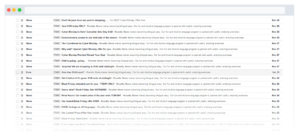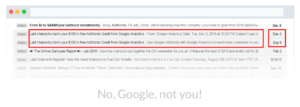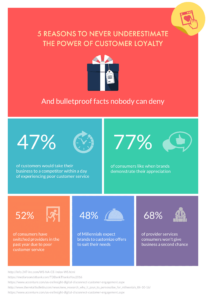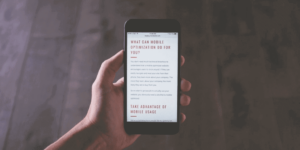Remember that moment from Harry Potter? Well, that’s exactly how my inbox looks like before every single holiday 🙂
What’s more surprising is most of the emails came from just a couple of companies who wanted to get my attention with their holiday offers soooo badly. I’ve seen it before and as far as I can see, there’s more to come.

© Warner Bros. Entertainment Inc.
That’s how I came up with my own personal UN-checklist for holiday marketing we could use at Reply and share with those in need.
So, here’s the story…
Once, there was a time when holiday marketing meant a quick radio ad or a banner on the front of a shopping mall, but I can’t seem to remember it.
Neither do you, I guess.
What I do remember, is a time when most holiday offers were still worth your time and attention.
Rumor Statistics has it, they aren’t like that anymore. All you see is an endless flow of special offers, gifts, giveaways, discounts, lotteries and prize-winning promos that seem to never ever stop.
No wonder holiday marketing is often being misused these days. We’re so overloaded with all kinds of special offers that we’re doomed to become ad-blind long before we even earn the money to buy what’s being sold to us.
Nowadays, people aren’t sensitive to discounts of less than 30-40% and can’t care less about anything in the world other than gift cards.
I’m sure you can spot that big sale on Amazon or those Christmas deals on eBay, but can you think of an SMB company that really captures your attention with a nice holiday offer? More importantly, how can you become one of those companies whose holiday deals are really anticipated and valued?
There’s no magic pill (there never is).
But there are some practical steps you can take, such as avoiding actions that’ll annoy your prospects and customers. With that in mind, here’s my UN-checklist for any holiday marketing you’re planning.
If you’re doing even just one of these things, you really should stop before you totally ruin your relationship with your customers and lose them for good.
Bombarding your subscribers with emails
Seems obvious, right?
The reason I decided to focus on this one is that last Thanksgiving, I received 46 emails.
From a single company.
In one week.

Forty Six. No joke.
And no mercy to those who have to relentlessly clean their inbox instead of getting ready to celebrate.
I don’t usually mark marketing emails as spam, but after the first 15 messages this company sent me in only two days, I was sooo ready to do it. Eventually, I decided to “make lemonade” and share my story, hoping it would encourage at least some holiday abusers to reconsider their strategy.
One thing I know: I will never buy from this company.
Research shows I’m not alone. 55% of people ignore emails because they get too many emails.
The number one reason US smartphone users subscribe from a company’s messaging is too many messages/updates. How much is too much? 27% said one email a day, while 32% said two a day.
From personal experience though, the right number of emails to send will depend on what kind of relationship you have with your customers, and how much value they get from each message. The closer the relationship and the more value you offer, the more you can email without pushing them to unsubscribe.
If you’re not sure how much is too much, I recommend not outstaying your welcome. When it comes to email frequency, less is usually more.
Ignoring deal expiration

Not only can it be bad for sales, this one can be really bad for your client relationship building strategy. If you promote your offer as something limited, unique, worth hurrying up to seize the moment, you could be in trouble.
Big trouble.
Sure, time-limited offers can be very effective, however, the trouble comes when you abuse the strategy with fake scarcity, such as when your ‘limited’ sale lasts 18 years (such as UK furniture retailer DFS). While you might think extending your holiday deal seems like a sign of goodwill and you’re being a super nice person, your customers may see things differently.
You should never forget you’re talking to people, not businesses, even if you’re a pure B2B company. A person will read (or ignore) your email, a person will or will not learn about your product or service, a person (not company!) will decide whether or not to buy from you.
Adding just a couple of more days may be a really nice idea appreciated by those who didn’t have the time or availability to take a closer look. On the other hand, having one deal with many faces that seem to never end is not an option.
It makes your customers feel deceived and mistreated. What’s even worse, it changes their core attitude towards your holiday marketing to “always ignore” mode.
This doesn’t just apply to never-ending deals. One site I know shows the stock going down on the item while you’re watching, but when you refresh the site the stocks back up to the original amount. Even though I wanted the item and it was at a good price, I refused to buy from them.
Don’t say it’s my last chance to purchase this product or service at this never-to-be-repeated low price, followed by another 5, 10, 15 ‘last’ chances. If you don’t respect me enough and assume I’m that stupid, then we’re done before we even start our conversation.
Even if you think Thanksgiving is immediately followed by Christmas Eve, take a pause and give your leads a chance to get some rest before you start another campaign with another offer. This will mean, even if they’re not eagerly anticipating your next deal, they’ll at least pay attention to what you have to say this time.
Forgetting about existing customers
The next item in my UN-checklist for holiday emails is giving all your attention to new prospective customers over existing ones. Even now, when everyone knows the huge power of upselling, lots of companies come up with shiny deals for new clients, completely forgetting about those who’ve been with them “all these years”.
And like in every relationship, this is the beginning of the end.
The Breakup.
It may seem small to you, but when your customer sees dozens and dozens of discount offers only for newbies, they feel underrated and disrespected, almost betrayed. Then when they find out about those deals from an email (rather from a public page on your website or promo banner), it makes them feel even worse because it means you don’t care about their feelings.
Like, at all.

In the UK, 83% say they now retract their loyalty more quickly than they did 3 years ago.
57% of UK consumers spend more on the brands they’re loyal to.
50% of UK consumers will recommend those brands/organizations to their family and friends.
50% have switched service providers in the past year.
9% publicly endorse or defend a brand or organization on social media.
Source https://www.accenture.com/gb-en/insight-customer-loyalty-gcpr
58.6% of American consumers interact with brands on social media 1-3 times per day.
62.3% of social media users are influenced to make a purchase through social media.
Source https://www.accenture.com/gb-en/insight-retail-purpose
But we have to work harder to maintain that loyalty. 50% have switched service providers in the past year. In Q1 2014, 84% of Millennials said they were at least somewhat loyal to their favorite brands. In Q1 2017, that number dropped to 78% (12% lower than Baby Boomers).
Source https://civicscience.com/brand-loyalty-among-millennials-continues-to-decline/
With such things on their mind, they can easily leave you for one of your competitors — one that pays more attention to the art of retention and encourages customer loyalty on a regular basis.
To avoid this sad and lonely scenario you only need to make sure you have these three things done:
Segmenting your email database so that your contacts only receive offers intended for them.
Make sure most of your deals are available to both existing and potential customers.
Put effort into keeping your clients happy and showing you really care about them (a special offer for customers that have been with your company for XX months is a nice plan to begin with).
Destroying your brand for the holidays

Branding is a powerful tool for businesses, one that can form a USP that helps them stand out from their competitors.
Yet, when the holidays roll around, companies will often throw out all their effort and hard work, sounding like every other company clogging up your inbox.
At its most obvious, branding incorporates the physical appearances; factors like font, colors, and imagery.
Let’s say you use cool blue colors, traditional Times New Roman font, and sleek modern photos in your emails and website.
Those are part of your brand.
That means when Christmas rolls around, you don’t suddenly change to warm red colors, Comic Sans font*, and cartoons of jolly ol’ St. Nick.
You stay on brand.
Powerful brands are about more than appearance though. At their best, a brand is entwined in the company’s ‘why,’ revolving around their mission and positioning in the market.
So if part of your brand is top range, high cost luxury goods, then promoting cheap kitsch products may do more harm than good.
If you normally use a formal, understated voice in your communication, screaming out about ‘OMG massive holiday sales!!!’ will confuse your audience.
Sometimes that’ll mean not running any promotion at all.
For example, retailer of infuriating self-assembly furniture Ikea didn’t put on any promotions over black friday.
Emily Birkin, their head of sales for UK and Ireland, explained why:
“Low price is the cornerstone of the IKEA vision and we will always remain focused on providing a range of home furnishing products that are affordable to as many people as possible.
“Each year we look at how we can invest in reducing our prices even further, from design and production to more efficient packaging and transport. Our ambition is to offer everyday low prices all year round, which is why we don’t take part in temporary discounting events.”
Notice how she refers to the ‘cornerstone of the IKEA vision’ being behind their decision. That’s what being on brand means.
In line with their unique brand, the company behind the incredibly politically incorrect game Cards Against Humanity have a history of pulling outrageous stunts on Black Friday. My favorite is where they literally sold nothing, for $5 a pop, and ended up raising $71,145. This year they offered 99% off a huge selection of random items including a Picasso lithograph, a wheel of cheese, and the spirit of Black Friday (a bargain at $999.99).
Every piece of content you produce, every page on your website, and every email you send should consistently reflect your brand.
That means even over the holidays.
When you look at your holiday campaign, is it instantly recognizable as an email from your company? Or is it indistinguishable from every other email your prospects will have that day?
*Pro Tip Comic Sans should never be part of your brand, period.
Make it a one day thing

While we wouldn’t want to bombard the customer (see above), that doesn’t give us an excuse to forget about our campaign until the last minute.
I received my first email referencing Black Friday prices on November 4th—19 whole days before Black Friday actually started. Amazon started their Black Friday sales on November 16th.
Why? Because a successful email campaign builds anticipation without overwhelming the customer.
When Experian analyzed emails over the Independence Day holiday they found that 79 percent of them were sent within two weeks of the Fourth of July, and 76 percent of revenue was received in the week of the holiday.
Some companies continued their promotions into the following week, but these weren’t as strong: overall revenue halved from $0.10 per email to only $0.05.
In short, while you may make some additional income by sending a single independence day email on July 4th, by creating a campaign that spans a couple of weeks you can maximize your returns.
Experian’s post suggests that other holidays may have a longer warm-up period, with searches relating to the holiday start up to four weeks in advance.
Remember, sending a series of emails does not mean bombarding the customer.
However, a series of well spaced out emails leading up to the holiday will yield the better results.
Ignore mobile devices

The chances are your email will be opened on a mobile device.
If you’re not optimizing your emails for mobile then you’re going to be missing out, but this is especially important for your holiday email.
For this year’s Black Friday, mobile devices made up 67% of all digital traffic (up from 61% in 2017) and accounted for the most orders on with 49% order share.
However, I’m still seeing plenty of promotional emails are stuffed full of poorly optimized imagery, endless pages of details and offers too small to see.
Guess how that goes down with your potential customers.
At best they feel frustrated, at worst they never even see your email.
Either way, the results aren’t pretty.
To get around this often involves thinking about the whole structure of the email; making sure it works as a bitesize blast, rather than a complete catalog of every product or service you offer.
It’s also a good idea to test your email to see how it looks on different devices. It may take a little longer, but it’s worth it to make your emails are going out as you intended.
Make it as easy as possible for your mobile customers to receive and read your email, and give them one clear call to action.
Making it all about sales

When thinking about holiday emails, it’s easy to think it’s just about the big sales event.
Go big or go home.
But this is a golden opportunity to engage with your audience, to make a stronger connection.
What does the holiday mean to you?
Do you have a holiday related story to share?
If you can converse in a genuine way with your customers, you’ll make much more of an impact than just another promotional email.
I’m not going to lie, this is easier said than done.
I’ve lost track of the amount of ‘thank you’ emails from marketers last Thanksgiving, most of which came across as heartfelt as a rock.
But if you can inject a personal touch to those emails, if you can convey your message honestly, then you’ll stand out in the sea of sales.
Now, just because I’m suggesting that your holiday emails don’t have to be promoting a sale, that doesn’t mean it shouldn’t be sent without purpose.
Rather, be aware that there are purposes other than direct sales.
You could direct people to connect with you on social media to share the festivities or encourage them to respond to the email, building relationships.
Every email you send should have a purpose, whatever the time of year, so decide on yours before you start writing your next holiday email, which will help you with the next item on the UN-checklist…
Blend in with everyone else

The holidays give you a good reason to email your customers. The problem is every other email marketer is thinking exactly the same thing. I received hundreds of emails regarding Black Friday, and I’m sure you did too. I’ve no doubt I’ll have plenty of ‘Merry Christmas Savings’ and ‘Start the New Year right with our sale’ emails over the next couple of months.
Most of these emails are instantly forgettable, to the point I go through them on total auto-pilot.
I’ll check the sender to see if it’s anyone I want to buy from.
I’ll scan the subject line to see what they’re offering.
If I’m still interested, I’ll have a glance at the email itself to check if there’s anything worth my time.
For the vast majority of holiday emails, I don’t make it past the subject line. Some recent highlights include such gems as:
Our best Black Friday ever
Black Friday Weekend >> All Deals Inside!
Black Friday is here
Now, I’m usually a big fan of clarity over cleverness when it comes to subject lines. But when you’re competing with hundreds of nearly identical subject lines, you need to come up with something a little more creative than this. At the very least, you need to give me a clue as to why I should care about your sale more than the others filling my inbox, letting me know what’s on sale at what kind of discount.
At the next level, try creating some curiosity. My personal favorite of this year’s contenders was ‘A deal you can take advantage of with your pants off.’
Ultimately though, there’s no substitution for providing consistent, year-round value with your emails. When someone emails me who already has a proven track record of value-packed messages, I’ll open and read that email whatever the subject line.
Assuming you’ve persuaded your customer to open your email, do your best to follow through with a unique, original message. Pebble reported on 7 brands who were doing something this Black Friday, such as Pukka Herbs (who are donating 100% of their online sales between Black Friday and Cyber Monday) and Rei (who closed their store on Black Friday and encourage their customers to get outside for the day and spend nothing).
Rather than sounding like every other marketer out there, take the time to come up with something that’ll make you stand out from the crowd. When you see everyone else zag, you’ve got to zig like mad.
Special holidays are a great opportunity to connect and engage with your customers, as well as promote any sales.
However, it’s all too easy to fall short, either by being lost among the rest of the promotional emails flooding inboxes or by driving your customers to the unsubscribe link.
Instead, make sure you uncheck all the items in this list, and you can make the most of the holidays.
To see what all the fuss is about
Request demo
Give your email campaigns the best chance of success at any time of the year by using Reply’s powerful email automation features. Take them for a spin today with a fully featured 14-day free trial.
Lucy Literado
VP of Marketing at Reply
![How to Know If Your Holiday Emails Are Too Much [Updated] How to Know If Your Holiday Emails Are Too Much [Updated]](https://reply.io/wp-content/uploads/holiday.mails_.4.new_.blog_-1080x567.jpg)



![Upselling and Cross-selling: The Go-To Guide [+7-Step Framework Inside] Upselling and Cross-selling: The Go-To Guide [+7-Step Framework Inside]](https://reply.io/wp-content/uploads/upsale-1024x538.jpg)

